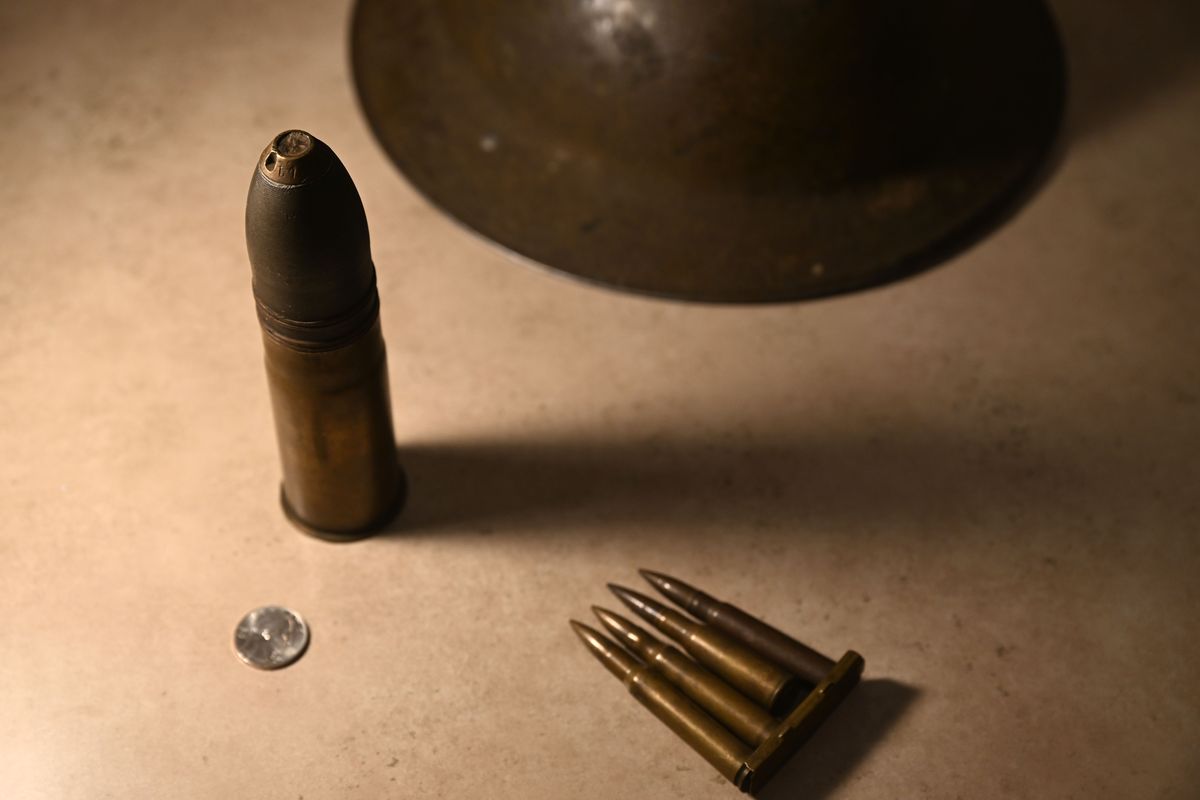Donation to Spokane Valley museum requires call to the bomb squad

A recent donation to the Spokane Valley Heritage Museum included ammunition and collectibles from World War I, shown Friday, Nov. 1, 2024. The largest ordinance pictured is a 37mm French-made artillery shell used by both French and American troops, and many were deactivated and brought back as souvenirs by soldiers.
It’s not unusual for people to walk into the Spokane Valley Heritage Museum with boxes of historical artifacts unearthed in the attic or garage. But it is unusual for such a donation of historical items to result in a visit from the bomb squad.
A local resident brought in a box of World War I items Wednesday that included historical battlefield photographs, an American military helmet, a German military helmet, a gas mask and a military uniform jacket. Also in the box were several artillery shells and bullets, which made Museum director Jayne Singleton pause.
Singleton knew from experience that old military ordinance can be unstable. About fifteen years ago, someone brought in a box of donations that included a World War II-era hand grenade. When she asked the woman if the grenade had been decommissioned, the woman said she didn’t know, but said it must be safe because her husband had had it for decades. In that case, Singleton called the bomb squad and found the grenade was still live.
With that previous situation in mind, Singleton removed the box from the building and made a phone call.
“I called the precinct and very nonchalantly explained,” she said. “It’s just unstable. It’s not a good idea to have historic ordinance just sitting around.”
She was soon contacted by a member of the bomb squad who asked for a picture of the items. There were three larger artillery shells and one that was smaller, plus the bullets. Soon, a lot of explosives experts arrived, including a team from Fairchild Air Force Base.
Singleton said the experts determined that one 37 mm shell and the bullets were safe, but the others were questionable. They told her that they weren’t even sure what the smaller object was, Singleton said.
“I was quite impressed by their procedures,” she said. “They X-rayed the shells so they could see if there was anything inside.”
The Air Force team removed several of the shells, but left the one safe shell and the bullets for the museum.
Singleton said she’s happy to have all the items, but doesn’t have any immediate plans for them. The photos will be added to the museum’s extensive collection of historical photos, which are digitized and available to researchers.
“The donation itself is extremely historically valuable,” she said.
The items will join other World War I artifacts the museum already owns, she said.
“We already did a World War I exhibit in 2019,” she said. “We do have quite a collection of military items.”
Singleton said the museum is not identifying the resident who made the donation.
“We certainly understand the donation was in good faith,” she said. “Most people don’t understand the potential danger of ammunition that’s very old. This is just something that happens every so often. We’re not mad about the recent donation.”
Singleton said she and her volunteers always are careful about the donations they accept. Over the years, she’s learned to refuse anything preserved in mothballs.
“Mothballs degrade into a really toxic substance,” she said.
Last summer, someone donated a sample of uranium in a glass jar, Singleton said.
“It was this beautiful shade of green and it had this glow,” she said.
Concerned about the safety of having a radioactive substance in the museum, Singleton consulted with several geologists. It was decided that it was best that the sample not be kept at the museum, she said. Instead, it was moved to a place where it could be stored safely, Singleton said.
“The public, in good faith, thinks ‘This should be in a museum,’” she said.
The museum, located at 12114 E. Sprague in Spokane Valley, is open from 11 a.m. to 4 p.m. Wednesdays, Fridays and Saturdays, as well as 11 a.m. to 5 p.m. on Thursdays.